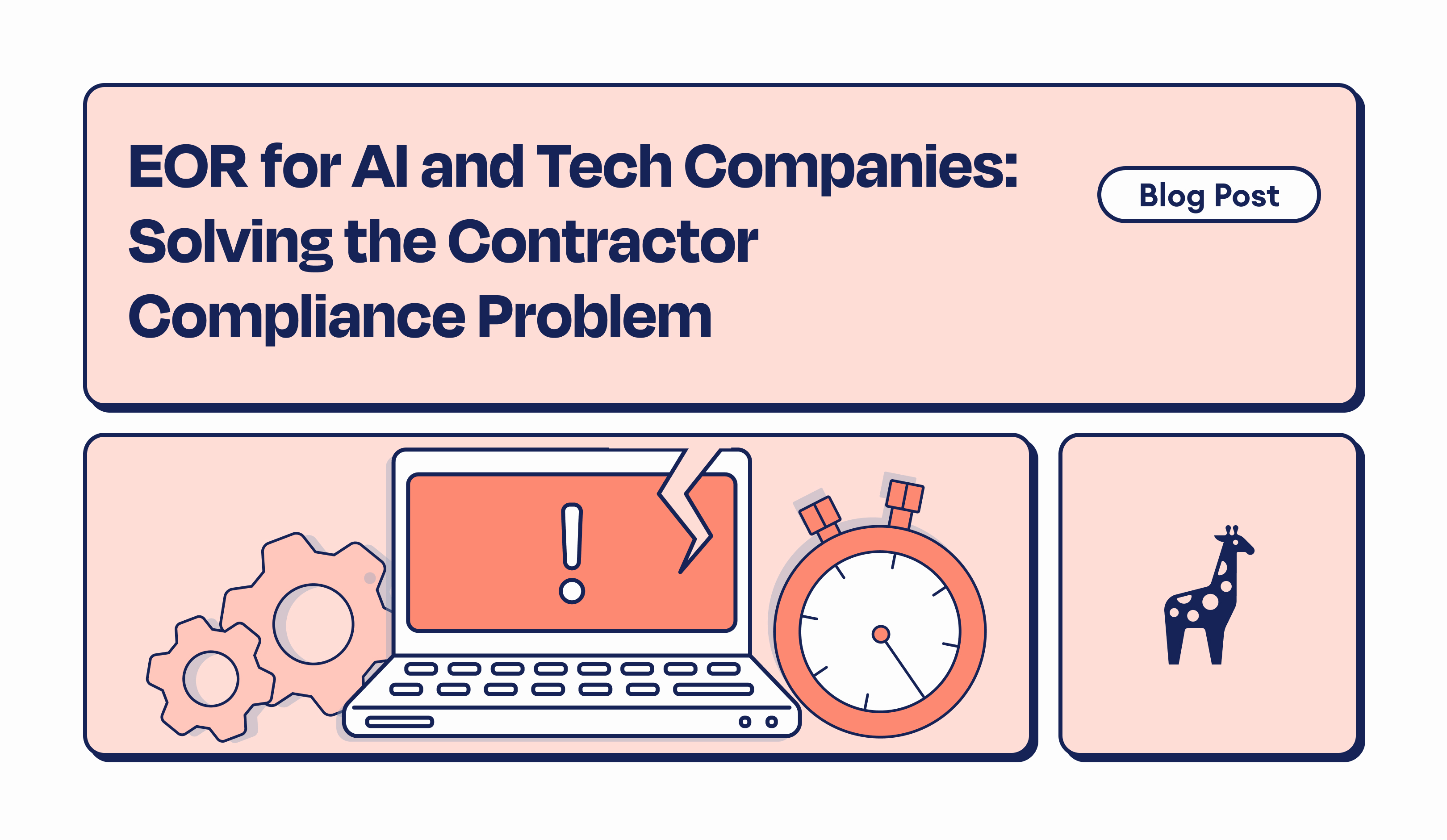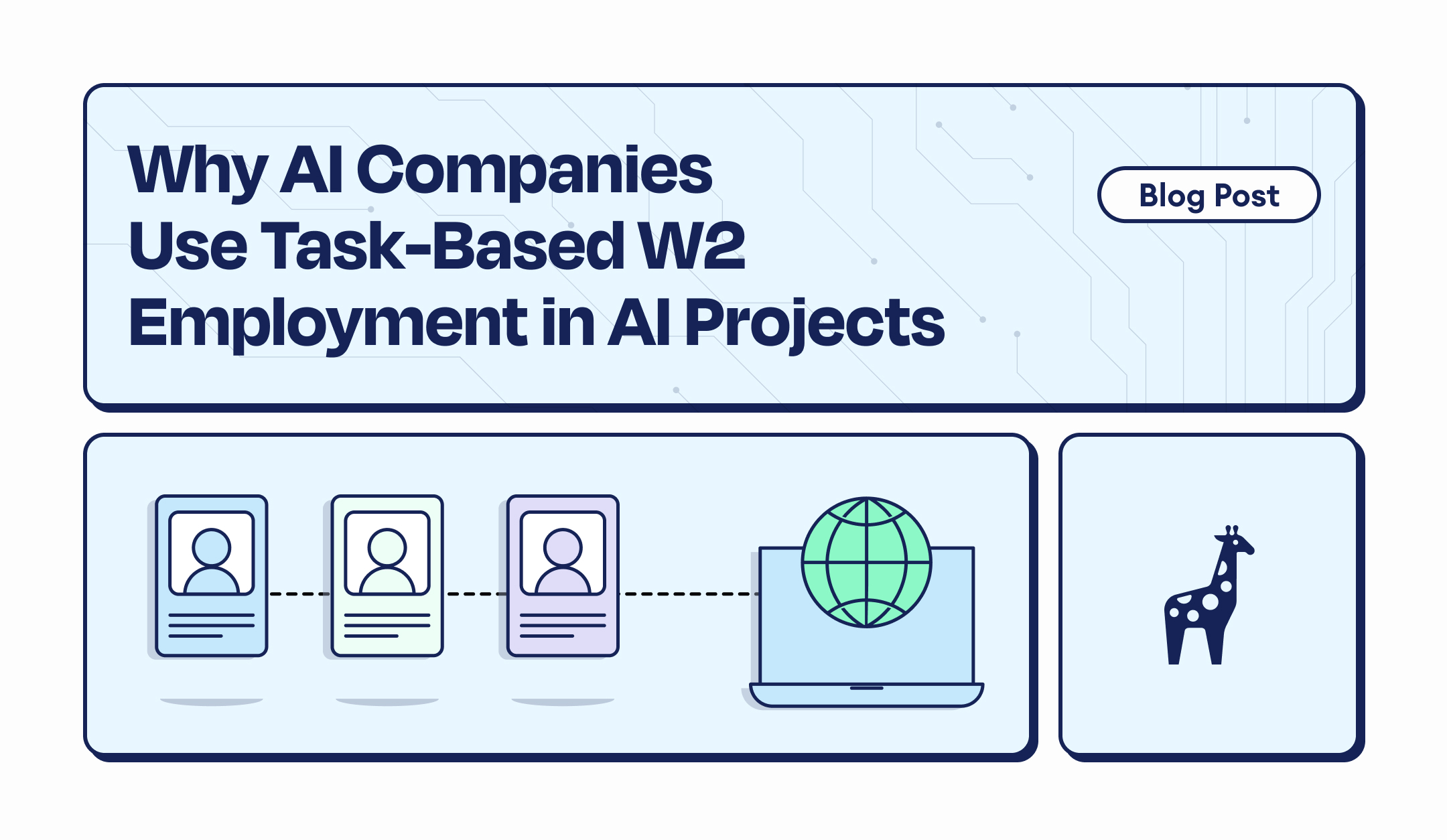AI and tech companies face contractor compliance risks. See how an Employer of Record (EOR) helps you pay data trainers, engineers, and contractors legally.

The AI boom has created an entirely new kind of workforce.
This new workforce is fast-moving, globally distributed, and deeply specialized. From data labelers and reinforcement learning trainers to AI project managers and SMEs, today’s AI companies rely on hundreds (sometimes thousands) of flexible contractors to build and refine their models.
But as this workforce scales, so does a less glamorous challenge: compliance.
In particular, AI contractor compliance has become one of the most pressing risks in the industry.
That’s where an EOR designed for AI companies comes in.
Ahem! That's where HireArt comes in, too.
Over the last two years, the explosion of LLM training and AI data labeling work has transformed how tech companies engage talent.
Many teams began with short-term 1099 contractors or crowdsourced contributors. This worked for a period of time. But once projects scaled and LLMs became more sophisticated , classification and compliance risks quickly multiplied. The 1099 "gig" solution was no longer the safest route.
The line between “independent contractor” and “employee” blurs fast in AI work.
Data trainers follow specific guidelines, use company tools, work defined hours, and receive direct feedback. These are all indicators of a W-2 employment relationship under U.S. law.
This means many “contractors” in AI workflows may actually qualify as employees. This misclassification exposies companies to risk of AI data worker misclassification — and the penalties that come with it.
AI companies hire from anywhere — but every state (and country) has its own wage, tax, and labor rules. Scaling annotation teams across multiple jurisdictions requires constant oversight and registration.
Unlike one-off creative or engineering projects, AI labeling and model training often demand repetition, oversight, and coordination — the hallmarks of employment, not independent contracting.
The result? A compliance time bomb that’s already going off across the industry.
An Employer of Record (EOR) is a third-party entity that becomes the legal employer for a company’s workforce.
The EOR handles everything from payroll and tax filings to benefits, I-9 verification, and compliance with state and federal labor laws — while the client (the AI company) directs the work.
For AI companies, that model solves three major compliance challenges at once.
By hiring data trainers, annotators, and project managers as W-2 employees through an EOR, companies ensure full compliance with worker classification standards.
That means no gray areas — and no exposure to IRS or DOL misclassification penalties.
An EOR for AI companies like HireArt already has legal entities and compliance infrastructure in all 50 states.
That allows employers to quickly onboard talent anywhere in the U.S. — even if they don’t have their own entity or HR team there.
W-2 employment under an EOR gives workers access to benefits, consistent pay, and legal protections that contractor status can’t offer.
That stability improves retention, engagement, and data quality — critical for long-term AI training programs.
For AI and tech companies, the compliance challenge isn’t theoretical — it’s financial.
According to the U.S. Department of Labor, misclassification can trigger:
If your company relies on hundreds of data labelers or model trainers, even a small misstep in classification or pay structure can multiply into six- or seven-figure liability.
Beyond cost, it can stall growth. This can cause enterprise clients or acquirers to become wary of your compliance record.
HireArt was built to make contingent workforce compliance simple, transparent, and scalable. Our specialty has become companies at the intersection of AI, robotics, and technology.
Since our platform combines EOR + sourcing capabilities, it serves the unique complexities of AI teams.
HireArt’s unique task-based W-2 model aligns perfectly with AI project workflows.
Workers are classified as W-2 employees, but assignments are structured around discrete data labeling or model training tasks — maintaining flexibility without violating labor laws.
We manage every compliance touchpoint, including:
Every contractor is properly employed and protected — and every employer is covered.
HireArt handles payroll, tax remittance, and benefits administration for AI teams distributed across all 50 states.
That means no separate PEOs, local filings, or HR intermediaries — just one unified, compliant system.
Our EOR compliance dashboards provide full visibility into employment data, taxes, and documentation, ensuring you’re always audit-ready.
For companies hiring AI trainers and annotators abroad, HireArt connects with vetted international partners to manage global compliance, from data privacy to employment law, under one umbrella.
AI development isn’t just about models. It’s about people.
The companies leading the next generation of AI innovation aren’t just optimizing algorithms; they’re building workforces that are ethical, secure, and sustainable.
By partnering with an employer of record for tech companies like HireArt, AI leaders can:
In a market increasingly scrutinized for fairness and ethics, compliant employment practices aren’t just good HR — they’re good business.
Think of compliance the same way you think of cloud infrastructure or version control. It's invisible, but also wholly essential.
The most successful AI companies don’t wait until a compliance issue arises; they build it into their operating system from day one.
HireArt’s EOR creates a scalable foundation for compliant, flexible work that supports innovation, not red tape.
AI and tech companies move fast — but compliance must move with them.
The key isn’t slowing down; it’s partnering with the right systems and experts to move smarter.
With HireArt as your EOR for AI and tech companies, you can focus on building the future of AI — while we make sure your workforce is compliant, protected, and ready to grow with you.


Why are AI companies increasingly using task-based W2 employment models? AI companies depend on a massive volume of specialized labor, especially when it comes to language training, data annotation, content moderation, and reinforcement learning.